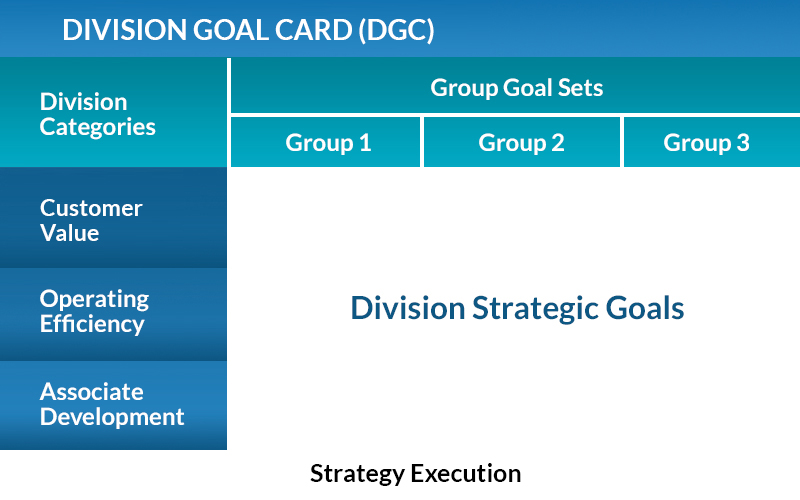STRATEGY EXECUTION
Achieving Strategic Plans
Achieving Strategic Plans
Strategy Execution for an organization is driven in an easily customizable Division Goal Card (DGC). The DGC documents the selected strategic initiatives and guides their Strategy Management Process. Strategy Execution requires the leadership team in each division to define winning strategies and manage their limited resources as required to achieve them.
A unique DGC is set up for each division in an organization. The DGC is used to document the strategic initiatives selected by their leadership team to gain competitive advantage. Each DGC is easily customized as required to drive the Alignment, Assignment, Management and ultimate Achievement for all of the division’s selected strategies.

Strategy Alignment assures that the strategies selected by the leadership team to gain competitive advantage align with the Division’s Vision, Mission and Values. V2R aligns the selected strategies in a custom tailored Division Goal Card (DGC). The DGC is set up like a spreadsheet. Goal Sets appear as columns in the DGC and are used to align an organization’s strategies by Group (i.e. Department). Goal Categories appear as rows and are used to group like strategies such as Customer Value, Operating Efficiency and Associate Development. Each selected strategy is added to the DGC based on its corresponding Division (column) and Category (row).
There is no “We” in accountability. Therefore, Strategy Execution requires individual accountability for each selected strategy that has been aligned in an organization’s DGC. V2R recommends the assignment of both a Manager and Owner to each selected strategy. They share joint responsibility for strategy achievement, but are held individually accountable for their specific roles in the Strategy Execution process.
Managers (i.e. Sponsors) for a strategy define the initial scope, seek approval, select the Owner (i.e. Project Manager), obtain required resources, review ongoing progress and assume overall responsibility for its timely and cost effective achievement.
Owners, selected by the Managers are responsible for assembling their project team, finalizing the scope, managing ongoing progress, achieving the scoped requirements and assessing their project team’s performance upon completion.
The only constant in Strategy Execution is that some things will not go according to plan. Organizations must be agile enough to correct for these digressions when they occur. Strategy Management monitors the ongoing progress of strategic initiatives. Deviations from plan must be identified, followed by the required corrective actions.
Two heads are typically better than one. In V2R, a Manager and Owner are responsible for achieving their assigned strategies. Collectively they hold each other accountable for successfully achieving the strategy’s scoped requirements.
A required step in the Strategy Management process are the regular review meetings where past actions, current risks and future plans for each strategy are reported and discussed. The DGC not only functions as the agenda for these regular review meetings, it is also the repository for documenting the discussions that occur. These documented discussions provide contemporaneous feedback directly to the strategy’s Manager and Owner while doubling as the meeting minutes for subsequent performance assessment.
How many times have strategies believed to be near completion only to suffer major setbacks when new problems surface that require substantially more time and effort to resolve? These last minute setbacks can have a major impact on how well the strategy was achieved. Therefore, strategy assessment should only occur when no further effort will be expended. At this point the strategy should be considered complete.
V2R uses a unique Rating Table defined for each strategy as part of the scoping process. The Rating Table is used to quantify how well the strategy was achieved. Strategy achievement can be measured quantitatively for metrics, or subjectively by Stakeholders for rated goals. Project teams assigned to a strategy should receive the same rating. This holds teammates collectively accountable for helping each other achieve the strategy’s scoped requirements. Getting every member of a project team working together drives Strategy Achievement that closes the Strategy Execution loop.

